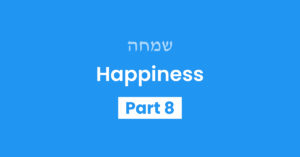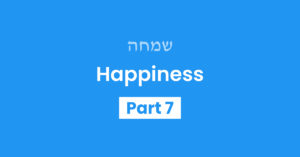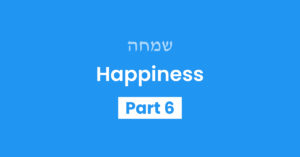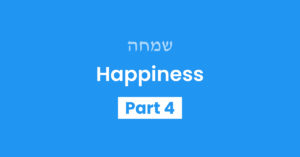Last month, we learned how focusing on what you have can help you feel happy. You can appreciate your physical possessions, your opportunities to do mitzvos, or the unique set of skills, talents, and life circumstances you were born with.
But inevitably, no matter how hard we try to focus on the good, the reality is that we all experience pain, lack, discomfort, or suffering sometimes. We can try to look away and focus elsewhere – but sometimes the pain and suffering is just too hard to ignore!
What then?
How can we continue to be happy during the rough times?
How can we continue to be happy during the rough times?
The answer, of course, is found in none other than…. Megillas Esther! 🙂
In the beginning of the Purim story, many horrifying things happen: Esther is taken to the palace and forced to live with the evil Achashveirosh. Haman rises to power and builds gallows to hang Mordechai. Haman plans to destroy the entire Jewish people on 13 Adar, and even gets the king to sign off on his plan!!!!
A terrifying story! If you were a Jew living in the times of Purim, you would be terrified. What will become of Esther? What will become of the entire Jewish future?
Indeed, the Jews were terrified. They prayed for their lives, fasted, and did teshuva. Suddenly, everything turned upside-down!
Suddenly, everything turned upside-down!
Instead of killing Mordechai, Haman was forced to lead Mordechai through the streets, giving him honor and respect. Esther (who was brought to the palace only as a result of Haman’s own advice to kill Vashi) hosted a party that brought about Haman’s downfall. Haman was then hanged on the very same gallows he had built to hang Mordechai! Finally, instead of 13 Adar being a day when the Jewish people were destroyed, 13 Adar was flipped to a day when the Jews defeated their enemies!
The whole Purim story is one long tale of bad things that were flipped into good. The very same events that seemed bad at first, ended up working out for our benefit.
The whole Purim story is one long tale of bad things that were flipped into good.
This is the message of Purim: That even when things look bad, bleak, dark, terrifying, and hopeless, Hashem is always with us and can flip those very same events into good. There is good hidden in every event in history – and in every single moment of our lives. We just aren’t always privileged to see it.
You might miss a bus, but find out later that the bus broke down, so it was a good thing you weren’t on it! Or you might burn a pot of soup, and find out later that one of the ingredients was spoiled and would have made you sick to eat it.
Or you might stub your toe, and… well, that’s it! We don’t always find out the good ending for every story. But we do know that Hashem does only good, so you can be sure there is good hidden in there.
The Greatest Display of Hashem’s Unity
How many times is Hashem’s name mentioned in the Megillah? ZERO! Never. Hashem’s name isn’t mentioned in the Megillah even once! His involvement in the story is totally hidden. But we can see clearly in retrospect that Hashem was there all along.
The Sifsei Chaim1 explains that this is actually the greatest revelation of Hashem’s unity and wisdom. When Hashem does open miracles, it shows His power to override the rules of nature. But when Hashem secretly manipulates world events such that both the bad AND the good end up serving good purposes – that shows even more powerfully that Hashem is One. Both the bad and the good come from One Source.
Chazal say: “Chayav Adam L’Besumei… A person must drink on Purim until he doesn’t know the difference between Baruch Mordechai (Blessed is Mordechai) and Arur Haman (Cursed is Haman).”
A person must drink on Purim until he doesn’t know the difference between Baruch Mordechai (Blessed is Mordechai) and Arur Haman (Cursed is Haman).”
Why on earth would Chazal want us to confuse Mordechai and Haman? Why didn’t they pick a different way to measure whether or not someone has reached the required state of drunkenness? Why not just ask us to try walking in a straight line?
The Sifsei Chaim explains that this symbolizes the entire message of Purim. Chazal want to teach us that Baruch Mordechai and Arur Haman are actually the same. (In fact, they have same gematria of 502!) It may look like some things are bad (Arur Haman), but really, both the bad and the good come from the same Source. Hashem is constantly watching over us and manipulating world events such that even the bad ends up working out for our benefit.
Baruch Mordechai and Arur Haman are actually the same.
Wiping Out Amalek
This week is Parshas Zachor. We read in shul about how Amalek attacked the Jews when they were leaving Egypt. Why do we read this right before Purim?
Amalek represents the antithesis of Purim. Amalek represents the ideology that everything happens through chance, as the Torah writes2: “Zachor es asher asa licha Amalek – Remember what Amalek did to you on the way when you left Egypt, that he chanced upon you (karcha) on the way… ” Rashi3 points out that the word karcha (chanced upon you) comes from the same root as “mikreh” meaning “coincidence.”
Amalek represents the ideology that everything happens through chance.
But on Purim, we remember the truth. Nothing is a coincidence, and everything comes from Hashem.
When we remember that Hashem is in control, and nothing happens by chance, this allows us to feel deep calm and happiness. Knowing that Hashem is looking out for us and taking care of us every step of the way can leave us feeling secure and reassured that all will be good.
We might not always see how every discomfort is ultimately for our good, but we can be sure that Hashem knows what He is doing. Dovid HaMelech writes in Tehillim (131:2) that he feels “K’Gamul Alei Imo” – as calm as a nursing baby upon its mother. A baby has no idea what’s going on. The baby doesn’t know its name, doesn’t know where it lives, doesn’t know where its food comes from or what time he will wake up tomorrow. But the baby knows one thing – that his mother is taking care of him. And with that one piece of knowledge, the baby feels totally calm.
We, too, don’t have to understand everything. As long as we know Hashem is taking care of us and will do whatever is best for us, we can feel a deep sense of calm and happiness. Everything Hashem does is for good, even when we don’t understand it yet.
Everything Hashem does is for good, even when we don’t understand it yet.
Sources: [1] Sifsei Chaim: Mo’adim Vol. II [2] Devarim 25:17-18; [3] Rashi 25:18
Your Challenge
When something bad happens, try to find a reason why it might serve a good purpose, and say it out loud. Try to think of a reason why it might be for your benefit.
It can be something that happened to you today, or something that happened to you in the past.
FOR EXAMPLE:
- “I can’t believe I’m stuck in traffic!! But you know what? Maybe it’s because Hashem wants me to spend extra time with my spouse/kids/friend in the car!”
- “Oh no! I thought we had more challah left in the freezer, but now I see we ran out! What a disappointment. Now I will have to bake more challos which will take a long time. But you know what? Maybe it’s because Hashem wants me to enjoy freshly-baked challos this week, or to get the zchus of hafrashas challah again.”
- “I am running SO late for work! But I know Hashem has a reason… Maybe I am missing an awkward moment or uncomfortable situation by coming late.”
Torah Questions
- Every month is associated with a different Shevet. Which of the 12 shevatim is associated with Adar? (Hint: Think of the fact that leap years have 2 Adar’s)
- One of the Avos was unable to get Ruach HaKodesh for many years because he was unhappy. Which of the Avos was it? (See Rashi on Bereishis 45:27)
- What made him happy again, such that he could now get ruach hakodesh?
- In Kabbolas Shabbos, we say a passuk that means: “When it looks like good things are happening to evil people, it’s just an illusion; Ultimately, the evildoers will be destroyed.” What are the words of this passuk?
- Which person in Megilas Esther walked around “Sameach V’Tov Lev – happy with a good feeling in his/her heart” until they saw something that made them upset? (See Esther 5:9)
- It says at the end of Megilas Esther: “Layehudim Haysah Ora V’Simcha V’Sasson Viykar.” The Gemara (Megillah 16b) says that Ora (light) refers to Torah. What does Simcha (happiness) refer to?
- Many times in Tehillim, Dovid HaMelech tells us what kind of things make him happy. What makes him happy? Bring a direct quote from a passuk to support your answer.
Questions to Ponder
- Were there any times in your life when you were able to be happy despite suffering or discomfort? Or did you ever see someone else who felt that way? How did you (or they) do it?
- How do you know that everything Hashem does is for good?
- Why was Adar chosen as the month that is doubled in a leap year?
- Why does a person need to be in a state of happiness in order to receive ruach hakodesh?
- Chazal tell us that on Purim, the Jews accepted the Torah for the second time. How did the story of Purim motivate them to do this? Why didn’t they accept the Torah again after Chanukah or after any other major event in history? (See Strive for Truth, Vol. II pg. 123)
- How does love lead to happiness? (See Sefer V’hayeesa Ach Same’ach, page 50 on the bottom)






